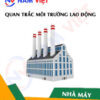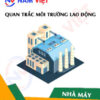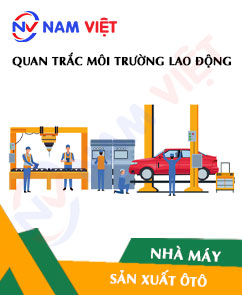Occupational environment monitoring at the factory producing dried meat products
99,000 ₫
Note: The above price is calculated for one sample, the price may fluctuate depending on the area of the environment to be monitored and the movement of the market. For more accurate price support, please refer to the quotation table or contact directly with our consulting staff.
Environmental monitoring of factories producing dried meat products is a session of collecting, analyzing, and evaluating factors in the workplace that may be harmful to the health of workers.
Table of Contents
Toggle1. Overview of dried meat factory
a. What is a dried meat factory?
Factory of dried meat is a food processing facility specializing in the production of dried meat. Dried meat is a method of processing meat by removing water from the meat to reduce moisture, thereby extending preservation time and creating a product with distinctive flavor.
Dried meat factories often comply with food safety and industrial hygiene regulations to ensure the safety and quality of the product.

b. Production stages in dried meat factory
In the dried meat production process, the main steps may include:
- Meat preparation: Selecting suitable types of meat for dried meat processing, including beef, pork, poultry, or seafood. Fat is removed, bones are separated, and meat is cut into small pieces or strips.
- Marinating: Meat is marinated with mixtures of spices, salt, and other additives to create distinctive flavor and enhance the drying process.
- Drying: Meat is placed in drying systems, such as hanging systems or drying trays. The drying process occurs at adjusted temperature and humidity to reduce meat moisture without losing flavor and nutrients.
- Quality control: Dried meat products are inspected to ensure quality, moisture, and flavor requirements are met.
- Packing and canning: After completion, dried meat is packed into plastic bags or packaging boxes to protect from light and humidity. This process may include the use of automatic packaging machines.

c. Types of machinery used in dried meat factory
In the dried meat factory, many types of machinery and equipment are used to perform processing and production stages. Below are some common machines often used in the dried meat production industry:
- Meat cutting and processing machines: Automatic meat cutting machines or meat cutting tables are used to cut and process meat into small pieces or strips suitable for the dried meat production process.
- Marinating machine: Used to marinate meat with spices, salt, additives, and other ingredients to create the distinctive flavor of dried meat.
- Drying machine: The main equipment for drying meat. There are many types of drying machines, including tray dryers, hanging dryers, or vacuum dryers, depending on production scale and technology requirements.
- Packing machine: Automatic packing machines are used to pack dried meat into plastic bags or packaging boxes. These machines usually adjust and automatically control packaging processes such as measuring product quantity, sealing bags, and applying preservation technology.
- Measuring and inspection machines: Devices to ensure quality and moisture of dried meat. These may include moisture meters, weight checkers, spectrometers to determine quality and flavor.
- Cooling and environmental control machines: For large dried meat factories, cooling machines and environmental control systems are used to maintain appropriate temperature and humidity during production.
- Washing and sanitation machines: Used to clean equipment, machinery, and work areas, ensuring hygiene and food safety.

d. What occupational diseases can workers in dried meat factory suffer from?
Workers in dried meat factories may encounter several occupational diseases related to the working environment and production process. Below are some common occupational diseases that may occur:
- Respiratory diseases: Workers may be affected by respiratory irritants such as meat dust, meat vapor, or flavoring. This may cause bronchitis, asthma, pneumonia, or other respiratory system issues.
- Skin diseases: Contact with detergents, disinfectants, or other chemicals during dried meat production may cause skin irritation, dermatitis, eczema, or other skin problems.
- Ear problems: Machinery and production processes may generate high noise, negatively impacting workers’ hearing, causing problems such as hearing loss or ear trauma.
- Spine and joint diseases: Jobs requiring continuous physical effort, repetitive movements, or uncomfortable postures may cause issues with spine, musculoskeletal system, and joints such as back pain, cervical spondylosis, or joint degeneration.
- Stress and psychological problems: Working in stressful and pressured environments may cause psychological issues such as stress, depression, anxiety, or mental exhaustion.
To prevent occupational diseases, it is necessary to establish health and labor safety protection measures, provide personal protective equipment, ensure safe working conditions, train and educate employees about safe working procedures, and comply with health and safety regulations and guidelines.

e. Common types of dried meat products on the market
There are many popular types of dried meat products on the market, each with its own processing method and characteristics. Below are some common dried meat products:
- Dried beef: This type is made from fresh beef. Beef is cut into thin slices or strips, marinated with spices, and then dried. Dried beef usually has a salty taste, provides high protein, and is a favorite snack for many people.
- Dried pork: Dried pork is a popular product in many cultures. Pork is cut into small pieces or strips, marinated with spices, and then dried. Dried pork may have different flavors, from salty to sweet, and is used in many dishes and snacks.
- Dried chicken: A popular dried meat product in packaged foods and snacks. Chicken is cut into small pieces or strips, marinated with spices, and then dried. Dried chicken has the distinctive flavor of chicken and is an attractive protein source for consumers.
- Dried fish: A product made from fresh fish. Fish is cut into small pieces or strips, marinated with spices, and then dried. Dried fish may have various flavors and can be used in dishes such as salads, noodles, or eaten directly as a snack.
- Dried poultry: Besides dried chicken, there are other dried poultry products such as duck, quail, or muscovy duck. These types are processed similarly to other dried meat products by cutting, marinating, and drying.
- Cured meat: Not completely dried like other dried meat products, but still has low moisture. Meat is cut into thin slices or strips, marinated with spices, and then dried in a special process to retain natural moisture. Cured meat usually has a salty taste and is used in sandwiches and other cold dishes.
2. Overview of occupational environment monitoring service
a. What is occupational environment monitoring in dried meat factory?
Occupational environment monitoring (or measurement of occupational environment) in dried meat factory is the activity of collecting, evaluating, and analyzing measurement indicators of occupational environmental factors at the dried meat factory, in order to take timely measures to minimize environmental harm to workers’ health and prevent occupational diseases. Occupational environment monitoring is a mandatory regulation for dried meat factories.
Occupational environment monitoring plays the most important role in caring for, protecting, and improving workers’ health because the main resource of the enterprise and the direct source of profit is the workers. Workers frequently exposed to occupational hazardous factors beyond permissible standards will be affected in health and may develop occupational diseases.
REGISTER FOR OCCUPATIONAL ENVIRONMENT MONITORING SERVICE
b. Occupational environment monitoring program of Nam Viet
The occupational environment monitoring program of Nam Viet is a program researched by monitoring engineers in the field of occupational safety and environmental protection. With the goal of ensuring workers’ health and safety, this program uses modern measuring methods to monitor air quality, water, microclimate factors, physics, dust… in the working environment. This is a very important program in ensuring a safe working environment and protecting workers’ health.
In addition, the occupational environment monitoring program of Nam Viet also plays an important role in researching and developing new solutions to improve occupational environment quality. With the dedication and professionalism of the monitoring expert team, the exclusive monitoring program of Nam Viet is becoming a breakthrough in the field of occupational safety management and environmental protection in Vietnam.

c. Standardization in occupational environment measurement process
Standardization in occupational environment measurement process of Nam Viet is a very important aspect in ensuring the quality of measurement results. To ensure accuracy and reliability of measurement results, this program uses recognized standards and standardized procedures of the Department of Health Ho Chi Minh City. This ensures that collected data will be used with high reliability in evaluating the occupational environment and making decisions to improve the working environment to protect workers’ health.
These standardized processes also ensure that measurement results are conducted by monitoring specialists with high qualifications and many years of experience, helping managers and experts trust the results from An Toan Nam Viet and make accurate and valuable decisions in protecting workers’ health and the environment.
By applying standardization in the occupational environment measurement process, Nam Viet is demonstrating its commitment to ensuring a safe working environment and protecting workers’ health, while also positively contributing to the development and improvement of occupational safety management and environmental protection quality in Vietnam.
d. Monitoring reports in dried meat factory
The occupational environment monitoring results are prepared according to form No. 04 Appendix III issued with Decree 44/2016/ND-CP and prepared in 02 copies: 01 copy sent to the labor facility that signed the contract for occupational environment monitoring and 01 copy kept at the organization performing occupational environment monitoring.
The storage period for occupational environment monitoring results according to the law is indefinite file storage.

e. Frequency of occupational environment monitoring according to law
According to Clause 2 Article 18 of the Law on Occupational Safety and Hygiene 84/2015/QH13, employers must organize occupational environment monitoring to evaluate harmful factors at least once a year.
f. Deadline for submitting occupational environment monitoring reports according to law
The deadline for submitting the report is before December 31 every year. Enterprises belonging to production facilities are required to submit occupational environment monitoring reports to the Department of Health at the locality where the main headquarters and workers are located.
When there are changes in technology processes, production processes, or when renovating or upgrading labor facilities with potential new harmful factors to workers’ health, enterprises belonging to production facilities must update occupational hygiene records related to harmful factors requiring occupational environment monitoring.
g. Regulations on penalties for violations of occupational environment monitoring for employers
According to Article 27 of Decree No. 12/2022/ND-CP dated January 17, 2022 regulating administrative penalties in the field of labor, social insurance, and Vietnamese workers working abroad under contracts.
- Clause 2: A fine of 2,000,000 – 5,000,000 VND for employers who do not publicly announce to workers at occupational environment monitoring sites and at inspected and evaluated sites the results of occupational environment monitoring and results of inspection, evaluation, and management of hazardous factors at the workplace immediately after results are available.
- Clause 3: A fine of 20,000,000 – 40,000,000 VND for employers who fail to conduct occupational environment monitoring to control harmful effects on workers’ health as prescribed by law.
- Clause 4: A fine of 40,000,000 – 60,000,000 VND for employers who collude with organizations conducting occupational environment monitoring to commit fraud in occupational environment monitoring activities but not to the extent of criminal liability.
3. Harmful environmental factors for workers in dried meat factories
Workers in dried meat factories may be exposed to harmful environmental factors. Below are some potential environmental factors that may harm workers:
- Dust: The process of cutting, grinding, and processing meat can generate meat dust in the air. Inhaling meat dust may cause respiratory irritation and health problems such as pneumonia and allergies.
- Chemicals: Chemicals such as detergents, preservatives, or coloring agents may be used during dried meat processing. Exposure to these substances may cause skin irritation, dermatitis, respiratory problems, or other health issues.
- Smoke: During the drying process, smoke from heat treatment may be generated. Inhaling meat smoke may cause respiratory irritation and may contain harmful compounds such as residues and carcinogenic substances.
- Noise: Machinery and equipment in dried meat factories may generate high noise levels. Continuous noise may affect hearing, cause stress, and negatively impact overall health.
- Temperature and humidity conditions: The meat drying process requires controlled temperature and humidity conditions. Improper temperature and humidity may create an uncomfortable working environment and affect workers’ health.
- Bacterial and microbial agents: The dried meat processing process may provide an ideal environment for bacterial and microbial growth. Exposure to these agents may cause infections or diseases.
REGISTER FOR OCCUPATIONAL ENVIRONMENT MONITORING SERVICE
4. Measures to improve the working environment in dried meat factories
Improving the working environment in dried meat factories is very important to protect workers’ health and safety. Below are some measures that can be applied:
- Ensure ventilation and exhaust fans: Ensure an effective ventilation and exhaust system to remove dust, fumes, smoke, and other harmful substances during dried meat production. This helps reduce exposure and inhalation of harmful substances and improves air quality in the workplace.
- Provide personal protective equipment (PPE): Ensure sufficient and appropriate PPE such as masks, protective glasses, gloves, and chemical-resistant coats. Workers should be trained on the proper use and maintenance of PPE.
- Ensure electrical safety: Regularly inspect and maintain electrical systems to ensure safety and prevent fire or explosion risks. Electrical equipment must be used properly and comply with electrical safety regulations.
- Adjust temperature and humidity: Ensure the temperature and humidity control system in the factory operates effectively. Comfortable temperature and humidity conditions may reduce stress and increase work performance.
- Training and education: Provide training on safety and correct working procedures for all employees. This includes guidance on equipment use, safe working procedures, and occupational disease prevention measures. Raise awareness of risks and health protection in the workplace.
- Regular inspection and maintenance: Conduct periodic inspection and maintenance of equipment, machinery, and systems in dried meat factories. This ensures safe and efficient operation of equipment and reduces the risk of incidents.
- Periodically organize occupational environment monitoring in factories, collect and analyze harmful factors for workers, then adjust to reduce hazards to prevent occupational diseases for them.
5. Benefits of periodic monitoring in dried meat factories
An Toan Nam Viet provides enterprises with excellent benefits when using occupational environment monitoring services according to Decree 44/2016/ND-CP on the management and control of harmful factors in the working environment affecting workers.
- Enterprises may proactively control harmful factors in workshops or factories.
- Receive consulting and recommendations on measures to minimize harmful factors and improve the quality of the working environment.
- Indirectly protect human resources, the main factor in enterprises’ development process.
- Minimize the impact of occupational diseases on human health, thereby reducing future medical treatment costs.
- Workers’ health is improved, leading to guaranteed and maintained product quality and output.
- Comply with labor safety regulations and avoid legal risks.
- Create reputation and professionalism in all aspects, thereby enhancing the enterprise’s brand value.
The environmental monitoring service of Nam Viet is the solution to minimize the impact of occupational diseases, contributing to a healthy and high-quality working environment.

6. National occupational environment monitoring center
Occupational environment monitoring center of Nam Viet is a professional unit in monitoring and measuring occupational environment quality throughout all provinces in Vietnam. With an experienced team of monitoring specialists, the center uses modern measuring equipment ensuring accuracy and reliability.
In addition to providing monitoring services, the center also supports customers in planning, handling, and monitoring occupational environment issues. With the motto “customers are the center,” the center values customer satisfaction, meets all customer needs, and is committed to providing the best solutions for enterprises.
REGISTER FOR OCCUPATIONAL ENVIRONMENT MONITORING SERVICE
With investments in technology, equipment, and human resources, the monitoring center of Nam Viet has been becoming one of the reputable units in the field of occupational environment monitoring in Ho Chi Minh City with the following objectives:
- We always value our brand reputation and the quality of our service products.
- We provide customers with the best and most suitable solutions.
- Together with a team of experienced Masters and Engineers who aim to protect the environment and benefit enterprises.
- With the Nam Viet Monitoring team, your company will receive professional services from experts in the monitoring field along with the best cost incentives.
The occupational environment monitoring process at Nam Viet includes the following basic steps:
- Before conducting occupational environment monitoring, our company always ensures that equipment and machinery used for occupational environment monitoring are adjusted and calibrated in accordance with legal regulations.
- Properly and fully implement the occupational environment monitoring procedures committed to the Department of Health.
- Honestly report occupational environment monitoring results to employers.
- In case occupational environment monitoring results do not ensure safety for workers, Nam Viet will support by proposing remedial solutions, and the labor facility will carry out the following:
- Implement measures to improve working conditions to minimize the effects of harmful factors and prevent occupational diseases.
- Organize health checks to detect occupational diseases and related illnesses early for workers in unsafe working environments.
- Provide allowances in kind for workers according to labor law regulations.

7. Occupational environment monitoring service quotation
To help enterprises perform occupational environment monitoring in a professional and effective manner, Nam Viet provides customers with a service quotation for occupational environment monitoring with high quality and reasonable cost.
- Our monitoring quotation provides detailed information about the pricing of monitoring services we provide. This includes costs related to travel, measurement, analysis, and reporting results. Customers may be completely assured of the accuracy and reliability of monitoring reports we provide.
- We are committed to always offering the most competitive and reasonable prices in the market, and we are always ready to provide fast and professional consultation and answers to all inquiries about monitoring services.
- With the Nam Viet monitoring quotation, customers may easily choose service packages suitable for their needs. We are committed to delivering the highest satisfaction with professional service quality.
No comments yet












Review Occupational environment monitoring at the factory producing dried meat products
There are no reviews yet.